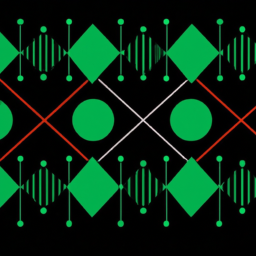
Harmonic Patterns Detection: Unlocking the Secrets of Market Analysis
Introduction
Harmonic patterns detection is a powerful tool used by traders and investors to identify potential trend reversals and predict future price movements in financial markets. These patterns are based on the concept of Fibonacci ratios and have been proven to be highly effective in technical analysis.
Understanding Harmonic Patterns
Harmonic patterns are geometric price patterns that repeat themselves in various forms across different time frames. These patterns are derived from the Fibonacci sequence, a mathematical concept that describes the natural order and symmetry found in nature.
There are several types of harmonic patterns, including the Gartley pattern, Butterfly pattern, Bat pattern, and Crab pattern. Each pattern has specific characteristics and ratios that define its structure.
Identifying Harmonic Patterns
To detect harmonic patterns, traders use a combination of price action analysis, Fibonacci retracement levels, and specific ratios. Here are the steps to identify harmonic patterns:
- Identify the initial swing move: Look for a significant price move in a particular direction, known as the XA leg.
- Apply Fibonacci retracement levels: Measure the retracement levels of the XA leg using Fibonacci ratios (typically 38.2%, 50%, or 61.8%).
- Identify the BC leg: Once the retracement levels are determined, identify the BC leg, which should retrace a specific percentage of the XA leg. This retracement is typically 61.8% or 78.6% of the XA leg.
- Apply Fibonacci extension levels: Measure the extension levels of the BC leg using Fibonacci ratios (typically 127.2% or 161.8%).
- Confirm the pattern: Look for additional confluence factors, such as support and resistance levels, trendlines, or candlestick patterns, to validate the harmonic pattern.
Trading Strategies with Harmonic Patterns
Once a harmonic pattern is identified, traders can use it to anticipate potential price reversals and plan their trading strategies accordingly. Here are a few common strategies:
- Pattern completion: Traders can enter a trade once the pattern is complete, placing a stop loss below or above the pattern’s structure and targeting the next Fibonacci extension level.
- Pattern failure: If the price fails to reach the projected Fibonacci extension level, traders can take advantage of the pattern’s failure by entering a trade in the opposite direction.
- Pattern confirmation: Traders can wait for additional confirmation signals, such as bullish or bearish candlestick patterns, before entering a trade to increase the probability of success.
Conclusion
Harmonic patterns detection is a valuable tool for traders and investors looking to enhance their technical analysis skills. By understanding and identifying these patterns, market participants can gain an edge in predicting future price movements and making informed trading decisions. However, it is important to remember that no trading strategy is foolproof, and proper risk management is essential when incorporating harmonic patterns into one’s trading approach.